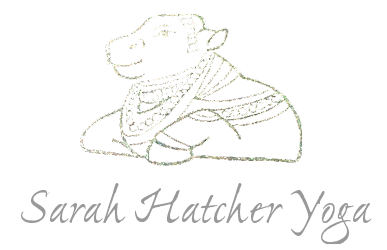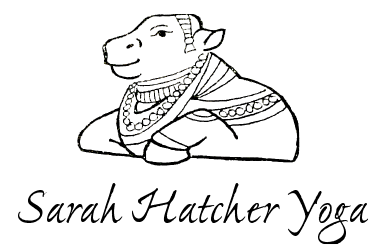Finding Truth
From what I see, yoga practitioners are getting more established in their home practices: people have designated places in their homes free of clutter and safe to practice. They have built their own backbending stations and have figured out how to bind in Marichyasana D without help. This incredible self sufficiency inspires me to practice even more dedicatedly when I see my students and friends maintain their practices during this very isolating time. Thank you yogis, who keep at it every day, joining me online and sharing your practice with me.
Of course it is fantastic to be in a shala, hear the breath of another person next to you and get specific adjustments; however here in Europe, this online home yoga is the new normal. When a yogi practices at home, it is their dedicated routine that makes practice successful. Maintaining a clean yoga space is part of this success as well as preparation - I lay my clothes out the night before and set them right on the mat for the morning’s 5 am start. Once the routine of daily practice is established, it isn’t that difficult to make it happen at home.
Students have to problem solve and figure things out for themselves at home: I love how couches are used; pillows and blocks and even unusual balls. Hey! These are perfect ālambanas, supports for successful yogic practice. I encourage different ways of trying difficult postures and urge people to get creative. I used to be pretty firm in my teachings:
“No, that is not in the series, you can’t add that in.”
And
”That is definitely off-piste, not a part of the method, leave that for another practice.”
Now I say:
”Try adding in three backbends before you try that Kapotāsana, it may be easier for you.”
And
“Let’s skip that posture for now and keep going. We will add that posture back in when you are a bit more comfortable with padmāsana.”
Ask me ten years ago, even five years ago if I would ever let anyone skip a pose. Not a chance. Now though, it is more important than ever for people to have the freedom in the method to design it right for them. We have to look at the time in our lives, the place where we are truly and sincerely at right now, and our circumstances. Someone may be going to through a very difficult time - instead of demanding that they follow a rigid routine, I’ve taken a step back. I have become better at watching my students. I may not be able to hear their breath, however their body language and actions are clear on the screen. I’ve become a better listener as well. I’m continuing to understand that ashtanga yoga practice is an invocation into the self!
When we understand this, it is a natural progression that the practice slightly changes or is modified any given day to fit into your life. The mature practitioner is looking to refine, explore, research, and listen to their intuition as they practice mindfully. They are seeking the truth that is within them.
An example of modifying or adapting the practice to what is right for you, you can take the vinyasa and jump back after you do the right side, or not; maybe for that day just lift up and switch to the left side taking a vinyasa after you finish that side. Perhaps your shoulder is bugging you, skip the vinyasa and do it differently tomorrow when your mind isn’t thinking or attaching to the pain or worry of your shoulder and you are more fresh. Do the practice daily that suits you, even if it means modifying it or shortening it. Here is a fun video that explains how you can “Supta…jump through with Straight-legs”, what you often hear during Led class when moving from downward facing dog to the next seated posture, Dandasana.
Dashiel counts out “supta jump through straight legs” and Sarah shows how to step through and then straighten the legs out; jump through with bent legs and then straighten the legs out; and how to jump through with straight legs.
Best-of practices are not to be looked down upon, go ahead and practice your yoga without the pressures of doing it a certain way because someone said it had to be done like that - design the practice for you. However don’t be lazy! If you have the time and the effort, practice as sincerely and potently as you can. Remember it is all about what is happening right now in your day. Are you commuting as much? Spend that time on your mat where you would normally be on a bus, riding your bike or in your car.
I wrote the following poem in 2015 when I was a dedicated blogger. I have uploaded my old blog here onto my website and you can find the unedited version of this poem there in the post, “Practical Practice Tips”.
“To Practice
I will practice today because the day is grey
I take practice today because the day is sunny
I practiced today because I needed to breathe
I needed to understand myself better
My body reminded me
I need to stop and be still
I am now ready to listen
I practice because no one tells me to
I practice because I feel the earth beneath me better
Often the practice smells like the food I ate yesterday
I’m covered in sweat and I am drooling
I often don’t hold it together
I’m as heavy as an elephant
I unravel
Sometimes during the practice
I am floating in the clouds, again with the Lord
My body is light and my mind doesn’t fight
I am like cotton
The earth enjoys my company
I join the world around me
I am taken care of
I do not have to be afraid
I love myself, my community and the blessed world
I practice today because I believe in it
and it believes in me”
The following two audio files - are of the same chant “Gurustutiḥ”. The prayer is to the ultimate teacher, which is Truth. Truth is a big part about your yoga - what is it that you are seeking when you practice every day? Reminding yourself that your practice is an investigation of your higher self, your quiet self, this is the practice of truth-seeking.
The two audio tracks here are special: the first file is an upload from studying with my teacher David Garrigues in London in 2016, and the second audio file is from last week here in Dublin. Notice how with time we start to integrate the special teachings we have learned and then understand them in our language - we have to dissect them a bit to understand their meaning and value. This is one of those chants. I never really understood why I would want to chant to the concept of ‘Truth’. It is so that we can peel away the layers of disguise and witness who we are.
Young Dashiel receiving a lovely Baddha Konasāna adjustment from David. London Intensive, October 2016.
Your home practice is about this truth. Building a comfortable space that is dedicated to your practice. Designing the time to explore your yoga and being open and willing enough to make changes to your practice if needed so you can continue to practice as dedicatedly as you wish. For those new to practice, I am teaching a Beginner’s Online Workshop the end of March so do join me for a tune-up to your practice or for an investigation of ashtanga yoga. Once you complete this class you may be more comfortable and ready to join the online zoom Mysore room.
Om! ॐ śāntiḥ śāntiḥ śāntiḥ
Thank you for joining me in yoga

